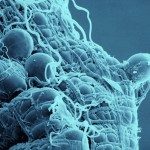Link to Pubmed [PMID] – 23349974
PLoS ONE 2013;8(1):e54820
Plasmodium falciparum is the causative agent of malaria, a disease that kills almost one million persons each year, mainly in sub-Saharan Africa. P. falciparum is transmitted to the human host by the bite of an Anopheles female mosquito, and Anopheles gambiae sensus stricto is the most tremendous malaria vector in Africa, widespread throughout the afro-tropical belt. An. gambiae s.s. is subdivided into two distinct molecular forms, namely M and S forms. The two molecular forms are morphologically identical but they are distinct genetically, and differ by their distribution and their ecological preferences. The epidemiological importance of the two molecular forms in malaria transmission has been poorly investigated so far and gave distinct results in different areas. We have developed a real-time quantitative PCR (qPCR) assay, and used it to detect P. falciparum at the oocyst stage in wild An. gambiae s.s. mosquitoes experimentally infected with natural isolates of parasites. Mosquitoes were collected at immature stages in sympatric and allopatric breeding sites and further infected at the adult stage. We next measured the infection prevalence and intensity in female mosquitoes using the qPCR assay and correlated the infection success with the mosquito molecular forms. Our results revealed different prevalence of infection between the M and S molecular forms of An. gambiae s.s. in Cameroon, for both sympatric and allopatric populations of mosquitoes. However, no difference in the infection intensity was observed. Thus, the distribution of the molecular forms of An. gambiae s.s. may impact on the malaria epidemiology, and it will be important to monitor the efficiency of malaria control interventions on the two M and S forms.
